Beyond Energy: How Glass in Architecture Contributes to Occupant Well-Being and Comfort
Glass as a multifaceted solution for post-pandemic commercial and residential construction
Sponsored by National Glass Association | By Erika Fredrickson
Glass is a significant architectural technology featuring versatile applications and the ability to achieve several purposes at once. The multifaceted material is used for transparent glazing in the building envelope to harness natural light and provide views. At the same time, it can incorporate safety characteristics that prevent severe weather or guard against assault—such as intentional breaking in or bullets—from affecting the building and its occupants. Glazing technologies have improved in the form of high-performance thermal systems, which can help building owners hit or surpass sustainability goals. The wide range of aesthetic possibilities make it a unique design element inside and outside, while still being functional on other levels. More recently, in light of a worldwide pandemic, glass offers a solution for homes and commercial buildings to help decrease virus transmission and make healthier, happier spaces for people.
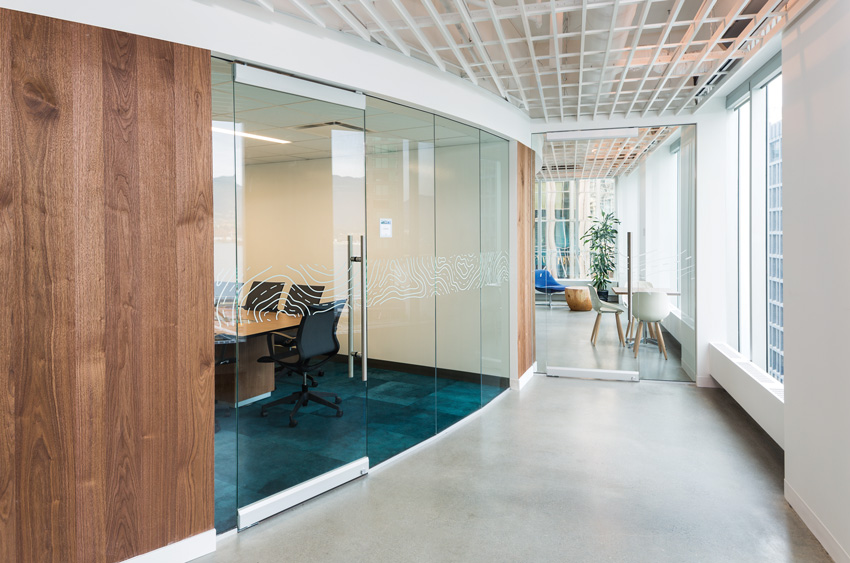
Photo: Geoff Captain; courtesy of C.R. Laurence
Shown is a clear-view glass partition system with a swing door.
Bird-Friendly Glass
There are so many functions that glass can perform in combination with its basic natural-light qualities. In fact, the glass industry is always finding new ways to meet design needs. One example is bird-friendly glass, which has recently become a hot topic in the glass world. According to the American Bird Conservancy (ABC), about 1 billion birds die annually from colliding with public and private buildings. The passive, invisible killer? Clear and reflective architectural glass. Windows of all sizes in both commercial and residential buildings in urban, suburban, and rural landscapes are thought to be invisible to most or all birds due to fly-through conditions, reflected habitat conditions, or a black-hole effect.
A fly-through condition is created when architectural elements provide birds with a clear line of sight to sky or vegetation on the other side. A reflected habitat condition is a condition in which the reflected image in glass is undisturbed and blends with the surrounding habitat (i.e., sky, vegetation). A black-hole effect, also known as a “passage effect,” is a condition in which glass can appear black due to lighting conditions and create the appearance of a cavity or passage through which birds can fly. All of these conditions can create hazardous environments for birds.
Specific buildings may accrue more bird deaths than others due to the large amount of glass and vegetation present. Bird collisions occur throughout the world at all times of day, in every season of the year, and under all weather conditions.
Even just 10 years ago, there was little science for bird-safe technology and very few products available to architects. Over the past decade, however, increased media attention to the issue has attracted the interest of the public as well as building industry professionals such as glass manufacturers, architects, developers, and landscape designers. The demand for bird safety has resulted in many products tested and marketed as bird safe, and research on bird-glazing collision prevention has guided the development of bird-friendly building design.
The key to bird-safe glass is in transforming clear and reflective glazing into barriers that birds will see and avoid.
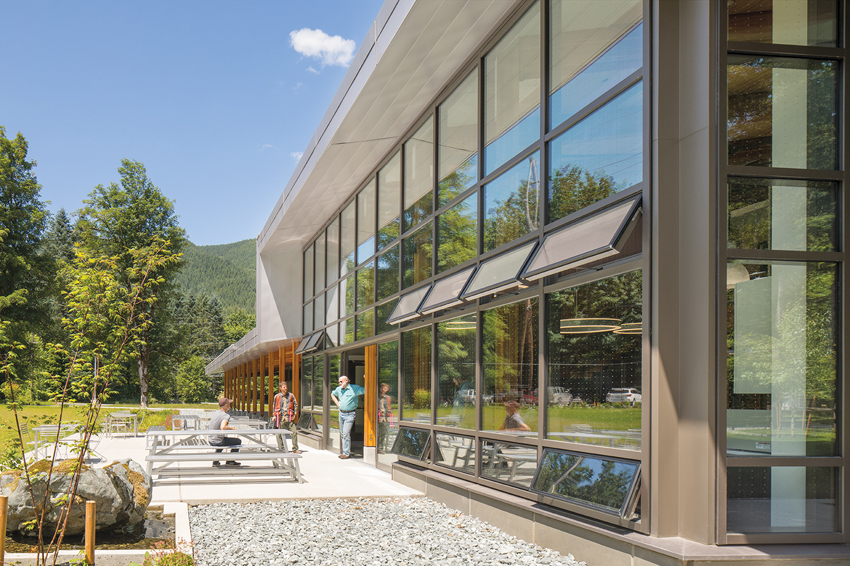
Image courtesy of Walker Glass Co. Ltd.
The City of Seattle’s Cedar River Municipal Watershed Headquarters located in North Bend, Washington, features bird-friendly glass with acid-etched designs so that birds can identify the glazing and avoid collision.
Solutions and Mitigation Strategies
Creating visual markers: Research has shown that birds begin to perceive buildings and houses as objects to be avoided when the distance between features or patterns on the glass is approximately 11 inches, with the most effective pattern distance at 4 inches edge-to-edge or less. The denser the pattern, the more effective it becomes in projecting itself as a solid object that is perceived by birds. The following glass and glazing products can help minimize bird-related injuries by creating visual markers:
- Etch
- Frit
- Film
- Decals
- Fenestration patterns of vertical and horizontal mullions
- Decorative grilles and louvers
- Artwork
- Ultraviolet (UV) patterns
Making architectural glass safe for birds is a responsible bird-friendly building design practice. The application of markers that are visible to birds and humans or visible to birds only and spaced 2 inches vertically or 4 inches horizontally on the outer pane of a window, with markers ideally located on or adjacent to the outer glass surface, will reduce bird-window collisions. Products following these prescriptive rules repeatedly have been shown to reduce collisions in an effort to help eliminate bird strikes. Products may be tested in order to verify the potential contribution to a bird-friendly design. The results of testing can provide documented third-party results of the threat factor (the lower the better) of a particular glazing solution.
Muting reflections: Muting reflections is an important strategy in glass facade design. Strategies to mute reflections include:
- Angled glass
- Awnings and overhangs
- Sunshades
- Screens, grilles, or mesh
- Shutters
- Louvers
- Window film
Dimming artificial lights at night: The bright artificial lights found in metropolitan areas can attract and disorient migrating birds. In cities located throughout North America, a program such as “Lights Out” may be effective in reducing bird deaths.
Studies have shown that creating visual markers, muting reflections in glass facades, and minimizing light pollution are ways to create more bird-friendly environments. There are a variety of glass and glazing solutions offered by glass fabricators and other stakeholders that will reduce bird collisions.
Legislation and LEED as Drivers for Bird-Friendly Glass
In June 2020, the U.S. House of Representatives passed H.R. 2, the Moving Forward Act, which included H.R. 919, known as the Bird-Safe Buildings Act. The bill mandates that all public buildings managed by the General Services Administration (GSA)—including new construction, newly acquired buildings, and buildings set for substantial renovation—be designed or altered with bird-friendly materials.
There are many exceptions, including buildings on the historic registry, but those that must become bird-friendly require that 90 percent of the exposed facade material from ground level to 40 feet be either not composed of glass or composed of glass with bird-safe modifications. It also requires that at least 60 percent of the exposed facade above 40 feet meet a modified glass standard, that there should be no transparent passageways or corners, and that all glass adjacent to atria or courtyards containing water features, plants, and other bird attractants also meet the glass standard.
Legislation is one way to push for bird-friendly glass. There are also incentives. The U.S. Green Building Council’s Leadership in Environmental and Energy Design (LEED) green building rating system now enables architects, designers, developers, and building owners to earn credit for incorporating design strategies that reduce bird collisions. The credit is currently being tested in the LEED Pilot Credit Library, a rating system development tool that encourages new or innovative green building technologies.
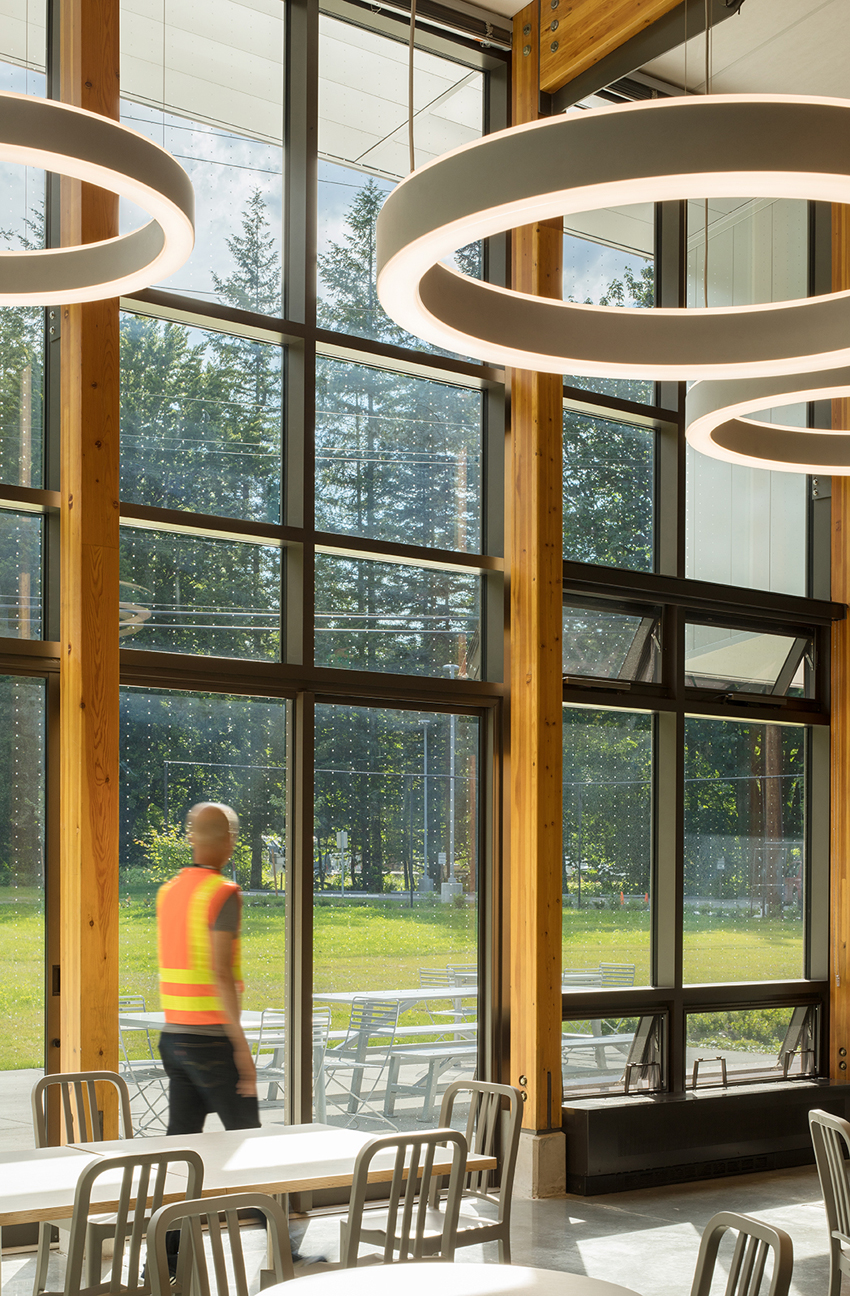
Photo courtesy of Walker Glass Co. Ltd.
Birds can perceive etching on glass and glazing products, which helps minimize bird-related injuries by creating visual markers.
Glass Is Essential to Occupant Wellness and Comfort
Especially during the 1970s, construction strategy focused on how to manage natural light by blocking it out and using artificial lighting techniques instead. But in recent years, research has shown how important natural light is to occupant well-being for mental state, physical health, and productivity. This rediscovery of natural light as an essential part of building design has led architects to not only incorporate natural light but also harness it in new ways—and one major way to do this has been with glass.
In addition, the global pandemic has shifted workspaces to the home, perhaps in some cases permanently. This section looks at how glass contributes to wellness and comfort, and how new designs using architectural glass are helping to create workspaces that are enhancing the home in new and exciting ways.
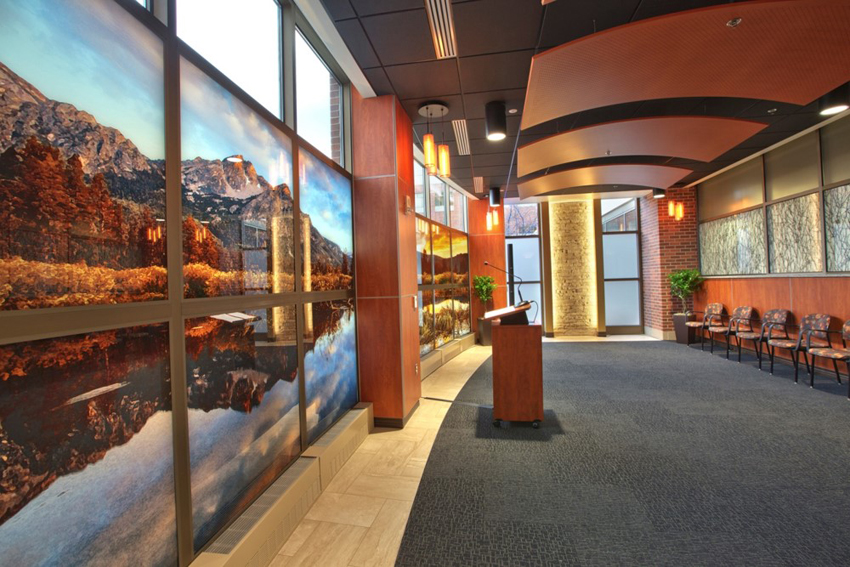
Photo courtesy of Hartung Glass Industries
Providing daylighting in hospitals—such as this example in St. Luke’s Meridian Chapel in Idaho—has shown to reduce patient depression, among other health benefits.
Connections between Glass and Well-Being
Humans are outdoor animals. Our bodies’ immune, cardiovascular, and metabolic systems and sleep-wake cycles depend on this light-dark cycle to function properly. Daylight at the right time improves our mood, helps us sleep better at night, manages our weight, and helps us ward off disease. The ability to view the outside environment is also important. On a physiological level, it helps us relax and refocus our eyes on the horizon. Being able to see nature is especially important. According to the U.S. Environmental Protection Agency (EPA), however, humans are are now spending 90 percent of our time indoors on average, keeping us from the light cycle that benefits our health. Given this statistic, it is clear that glass and glazing—with advantages of daylight, views, access to nature, and more—are essential to occupant wellness.
Healing Impacts
In a paper titled “Impact of Light on Outcomes in Healthcare Settings,” the Center for Health Design showed that maximizing access to daylight in hospitals had a positive impact on patients and a mitigating effect on negative aspects of the hospital environment.
Providing more natural light within hospitals—also known as “daylighting”—reduced patient depression, decreased the length of time patients spent in the hospital, improved sleep, and allowed dementia patients to feel less agitated. The positive outcomes also translated to staff, whose exposure to natural light helped regulate their circadian rhythms and provided them with better sleep and wake cycles.
This connection between natural light and health is not just a bonus. It is not just the fact that getting better sleep is good for you; it is that getting poor sleep has a negative effect that is compounded when a person has other health issues. In this study of natural light in hospitals, natural light helped mitigate potential negative effects that patients and staff were experiencing because of irregular circadian rhythms—health conditions that included sleep disorders, obesity, diabetes, depression, bipolar disorder, and seasonal affective disorder.
Learning Impacts
Besides the health-care study, numerous studies have demonstrated a relationship between glass and improved test scores among students. Good daylighting reduces eye strain, which helps with better reading, processing, and learning. In a study by the Heschong Mahone Group (HMG), students with the most daylight processed 20 percent faster on math tests and 26 percent faster on reading tests in comparison to their peers in the least-daylit classrooms.
Anecdotally, teachers interviewed for the study said that better windows with a view of nature helped both them and their students stay calm and regroup when stress levels began to rise. Another study indicated that lack of daylight impaired hormone patterns, making it more difficult for children to concentrate or collaborate with peers. These effects had potential long-term consequences, impacting growth and school attendance. HMG’s study suggested that better access to daylight and natural views could maximize learning and give teachers an extra month that they could use for other activities besides reading and math.
Workplace Impacts
In a study titled “Impact of Windows and Daylight Exposure on Overall Health and Sleep Quality of Office Workers: A Case-Control Pilot Study” published in the Journal of Clinical Sleep Medicine, two groups were monitored. The first group worked in windowless environments where there were either no windows or the windows were far away. The second group worked in spaces with access to windows and natural light. The well-being and sleep quality of both groups of workers were measured. Results illustrated that those without access to natural light sources during the day did not perform their duties to the highest capacity compared to the group that had access to daylight. They also experienced physical problems, diminished vitality, and poor or interrupted sleep.
According to “The Global Impact of Biophilic Design in the Workplace,” views of greenery and water through windows have been linked to lower stress levels for employees compared to those without a window. Data shows that the positive impact of daylight and views correlated with double-digit improvements in productivity, overall better quality of life, sleep, reduced sick leave and staff turnover, and an increased number of applicants for open positions because the job was seen as desirable.
The WELL Building Standard—a global rating system intended to transform buildings and communities—aims to make architects, designers, and building owners more aware of how a space can affect occupants and the environment, ultimately enhancing their experiences of spaces. The way people experience daily light can affect their circadian rhythms, which ends up impacting sleep cycles, which in turn impacts work lives. The WELL Building Standard’s illumination guidelines help protect the consistency of a worker’s wake and sleep schedule. One way that this happens is to experience natural daylight and darkness, maximizing natural daylight and outside views rather than relying on fluorescent light.
The Art and Science of Daylighting
Daylighting is the practice of placing windows, skylights, and other openings and reflective surfaces in buildings to provide internal lighting from the sun. The aim is to maximize comfort, provide pleasant visual effects, and reduce energy use. The results, of course, have even more significant influence given the health, learning, and work productivity benefits.
Daylighting is not a new concept or practice. Before electric lighting, building interiors were often dark—even during the day—but the evolution of architectural daylighting helped bring in natural light with great success. Early daylighting included a lot of windows: raised eyebrow (a window peeking out of the roof), patterned glass, portholes, transom windows, Dutch doors, and window seats featuring angled windows that played with light across the room.
The science of daylighting design is not just how to provide enough daylight to an occupied space but also how to do so without any undesirable side effects. Beyond adding windows or skylights to a space, it involves carefully balancing heat gain and loss, glare control, and variations in daylight availability. Daylighting designs take into account shading devices that reduce glare. The window size, spacing, glass selection, and how it reflects in a particular space on interior finishes all matter when creating a daylighting system. Typically, one or more of the following are present in a daylighting system:
- Daylight-optimized building footprint
- Climate-responsive window-to-wall-area ratio
- High-performance glazing
- Daylighting-optimized fenestration design
- Skylights (passive or active)
- Tubular daylight devices
- Daylight-redirection devices
- Solar-shading devices
- Daylight-responsive electric lighting controls
- Daylight-optimized interior design (such as furniture design, space planning, and room surface finishes)
Daylighting is best optimized in new construction when the whole original project can be designed around a daylighting system. However, the demand for more daylighting in commercial office and home office spaces has led to retrofit ideas that harness light and natural views in meaningful ways.
When it comes to walls, glass transmits light to adjacent rooms. A window placed above eye level helps diffuse light to the next room while maintaining privacy. Translucent glass panes or walls provide mellow light that a regular glass window cannot offer. Textured, laminated, or sandblasted glass will absorb and reflect light, sometimes scattering the rest depending on how translucent it is. The possibilities for creating light that is not glaring and complements a room are nearly endless.
Daylighting Homes in an Era of Remote Work
Before the COVID-19 pandemic, about 17 percent of U.S. employees worked from home five days or more per week. During the pandemic, this number increased to 44 percent as quarantines and lockdowns made commuting and office work nearly impossible. Remote work became a solution that proved in many cases to be a benefit rather than an impediment to both work productivity and quality of life—which go hand in hand.
As the pandemic winds down, more companies are looking to continue a hybrid or remote work model, which means more workers are seeing their homes and work spaces merge and sometimes collide. The architecture industry has picked up on this trend and in response has developed some home-office solutions that meet the needs of workers looking for permanent workspaces in their homes. A major focus of these trends is how to both designate workspaces—no more just sitting on couches or clearing off dining room tables—and provide the kind of daylighting that will promote health and well-being. Following are a few glass design trends resulting from this new era.
Transom Windows
A transom indoor window above a door adds a way to borrow light without sacrificing precious wall space. They were popular in the Victorian period as a way to add light when electricity was not available. When electricity did come into use, transom windows provided enough natural light during the day to keep lights off in some rooms, reducing energy use. The same concept is appealing today. Transom windows are aesthetically pleasing and can provide natural light into a designated office space inside the home even when the door is shut, allowing for privacy. Some transom windows are designed to open, which also allows for ventilation. A lightweight chain is attached so the window does not open too far. In other designs, the window can be hinged at the top so that it opens at the bottom.
Stairs
Stairs are an overlooked opportunity for transporting light, but a stairwell is a good place to borrow light from an upper story. Surrounding stairs with glass and white walls facilitates this process, especially if a stairwell is oriented to capture afternoon sunlight upstairs. The orientation of glass and the type of glass—whether it is a panel or blocks—can provide different ways of capturing light while also creating an aesthetically pleasing design.
Interior Windows
Frosted interior windows borrow light from adjacent rooms while still providing privacy. They also increase ventilation, and since interior windows do not require the same insulation, they are generally much cheaper. Open floor plans have been a trend for a while, but the need for a designated workspace is bringing architects back to compartmental design. Interior windows are a way to get the best of both worlds.
Skylights
Skylights can provide light into a closed office space. If the office space is on a lower level, skylights paired with light wells can carry light even farther to other stories. Because daylighting is a system, architects also think about other characteristics of rooms in conjunction with glass. For instance, white tile walls will especially help sunlight travel from a skylight to other parts of the room.
Glass Partitions
Glass partitions and other glass interior structural elements can be used to pull sunlight deeper inside a building. Extremely transparent, low-iron glazing with highly visible light transmission allows light from the outside to filter further into a room while also providing aesthetic structural elements.
Glass as a Protective Barrier against Environmental Forces
Glass is a strong material with the ability to hold up against even extreme environmental forces, such as hurricanes. The selection of glass for these extreme environments is key, and the options are wide ranging. When compressed, glass is in the same order of magnitude as steel when it comes to strength. This allows designers to incorporate glass into highly ambitious structural applications. Large glass panels can be fabricated up to 3.6 meters in width and 20 meters in length. The large glass panels can be laminated, hot bent, and cold bent, among other things.
This section will look at the durability of glass and how it is used as a protective structure against weather and other forces. While weather is the focus of this section, safety glass is obviously used for protection against break-ins and active-shooter scenarios, among other things. Selection of glass can be based on multiple objectives, and for security and safety in schools and other facilities—which you can read about in the sidebar on the next page—are other ways that safety glass can be used.
Safety Glass
As stated earlier, safety glass is glass with additional features that make it less likely to break or pose a threat when broken. Common designs include toughened glass (also known as tempered glass), laminated glass, and wired-mesh glass. Following are some examples of those types.
Monolithic Safety-Tempered Glass
Monolithic safety-tempered glass is a single glass lite or pane, but it is also safety tempered. Safety-tempered glass is approximately four times stronger than regular annealed glass and is called “safety glass” because when fractured, it breaks into smaller pieces, making it less likely to cause serious injury. Monolithic safety-tempered glass is also great for daylighting because it allows sunlight to penetrate into the building. This glass is best suited for areas that are not prone to forced entry, such as windows on upper floors.
A single glass lite with an applied film or plastic is also considered safety glass because it is safety tempered and will therefore break into smaller pieces when fractured. A single glass lite with film or plastic also allows for proper daylighting. This glass is more secure than standard single safety-tempered glass lites.
Laminated Glass
Laminated glass is made up of two or more lites that are permanently bonded by heat or pressure with one or more plastic interlayers to provide extra protection. This type of glass is great for areas that need added protection, such as entry doors or glass areas in banks, waiting areas, or other public spaces where safety is a concern. Another safety feature is that when broken, the glass stays contained instead of shattering. This is especially important in the event of forced entry or weather events that could cause flying debris. In addition to safety, laminated glass provides enhanced acoustics by keeping sound in areas where it belongs and out of places where it does not belong. It also provides daylighting for areas where glass may not have been an option before.
Laminated Insulating Glass Unit (IGU)
Laminated glass within an insulating glass unit (IGU) provides all of the benefits previously discussed for laminated glass but brings the added benefit of energy efficiency and resistance to adverse weather. Laminated IGU glass is also made up of two or more lites that are permanently bonded by heat or pressure with one or more plastic interlayers. However, laminated IGU glass provides an extra layer of protection thanks to the spacer that is placed between the two panes. Sometimes a laminated IGU is two laminated pieces of glass, and other times it is a single lite with a spacer and then laminated glass on the other side. This space between the two panes provides extra thermal protection and can limit unwanted heat transfer. This type of glass also can protect against impact from wind and rain in strong storms, such as hurricanes.
Multi-Ply Glass
Multi-ply glass is a high-quality fiberglass sheet that contains multiple inner layers and/or plastic glazing for added protection to withstand extreme conditions, including forced entry, blasts, ballistics, hurricanes, and tornadoes. As with laminated glass, it also can provide enhanced acoustics, keeping sound in areas where appropriate and out where not appropriate. In addition, it offers daylighting options for secure areas that may not otherwise have the chance at daylighting; for example, an area surrounded by a concrete wall for protection.
Glass as a Means for Artistic and Decorative Expression
Glass is able to create more than just a view, and it can provide more than the benefits of natural light. Glass designs can create entire moods and atmospheres. Glass affects a space in a phenomenological sort of way. Using natural light and a variety of colored and textured glass, it can help transform a building from purely functional to aesthetically profound. Architects and artists alike look to glass to create beautiful, durable spaces in and out of buildings, and glass fabricators provide nearly endless options for them to do so. Glass can be digitally printed, etched, silk screened, laminated with decorative interlayers, and more. Additionally, the industry is beginning to incorporate new technologies into glass and windows.
Emerging Technologies
Photo Realistic Designs
Glass fabricators can achieve resolution quality upward of 2,880 dpi thanks to advancements in printer technology. Designers can print nearly any design in photo-realistic quality on glass with the promise of durability and longevity.
Magnetic Marker Boards
Glass marker boards are a niche but increasingly popular application. The laminated safety glass boards serve as a writable wall cladding. Many glass suppliers offer magnetic marker boards, which are available in custom colors.
Switchable, Interactive Glass
Architectural glass companies are also developing switchable and even interactive smart glass products. Switchable products can provide privacy, turning from clear to opaque at the flip of a switch. The application is becoming more common in changing rooms and restrooms. Companies also are pushing to add interactivity to their switchable products for applications such as multimedia walls.
Old Trends Become New Again
Glass Blocks and Bricks
Glass blocks and glass bricks are design elements associated with the 1980s, but designers are bringing these elements back in ways that feel more updated. They still can be utilized in floor-to-ceiling facades, but they also can be used in more nuanced ways with interiors. Glass block walls can be broken up into smaller modules and incorporated with black frames. Cloudy blocks may evoke 1980s decor, but matte and warm tones provide an updated texture. In some cases, glass bricks can be utilized to evoke a retro vibe without overdoing it by framing modern furniture. Glass blocks and bricks emit a back-lit glow, so the elements around the blocks need to be incorporated into the design in a way that does not clash.
The Skyscraper Total Transparency Vibe
While many in the construction industry have argued since the 1990s that glass skyscrapers and large glass buildings would add to the energy load of urban areas, they were not taking into account the new technology in glass manufacturing. With today’s use of double-skin facades, energy is actually saved. What is more, less energy is used during daylight hours (when most people are working in these buildings) because unlike buildings constructed of brick, concrete, or other solid materials that require constant interior lighting, glass buildings are naturally lit. Additionally, the recyclability of glass products is becoming more apparent, both in terms of the number of glass recycling companies that exist and specifically what products can be recycled. This will significantly reduce traditional glass waste and conserve other natural resources needed to manufacture new glass.
The Potential of Vacuum-Insulating Glazing (VIG)
In developed nations, building energy consumption has grown to reach beyond 40 percent of total final national energy consumption. This high-impact growth in consumption comes as climate change continues its rise as a global threat. How can the design and construction industry turn the tide on energy efficiency and offer solutions to the problem?
One major issue is the inefficient use of energy in terms of indoor climate control for both residential and commercial buildings. Uncontrolled heat loss through the building envelope is a key problem to be solved—and the main culprit for this loss is windows.
While there are plenty of window solutions aiming to overcome energy loss, a unique alternative has emerged in recent years. Vacuum-insulating glazing (VIG) is a glass solution that provides high thermal performance in a thin profile. VIG is installed in new construction, restoration, and refrigeration applications. This section focuses on VIG technology and how it can be incorporated into various architectural elements and cooling systems.
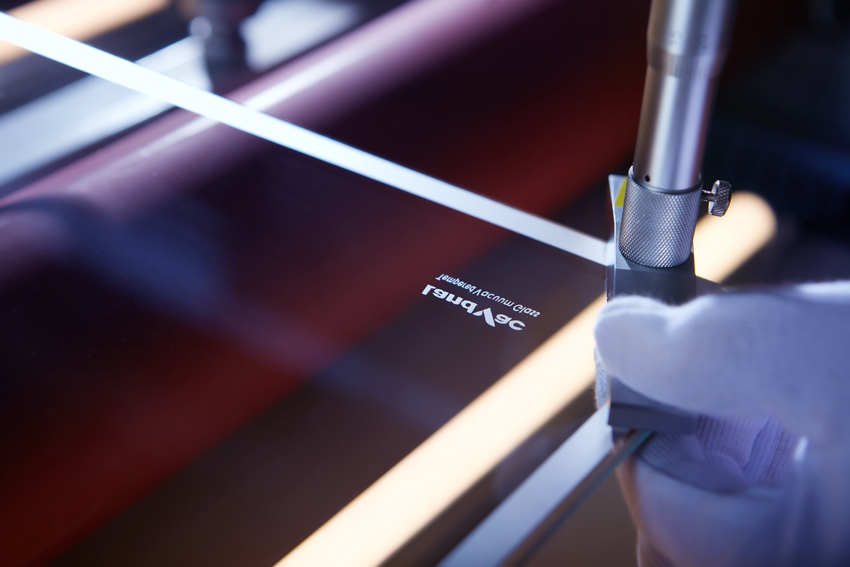
Photo courtesy of LandGlass
Vacuum-insulating glazing (VIG) offers thermal performance values that surpass those of traditional insulating glass units (IGUs) and in some cases begin to rival solid walls.

Photos courtesy of NSG Group
VIG was critical to the restoration of the 1955 Eero Saarinen-designed “Bird Cage”—a double cantilever staircase enclosed with a glass and steel curtain wall with elegant lines that emulate an ornate cage.
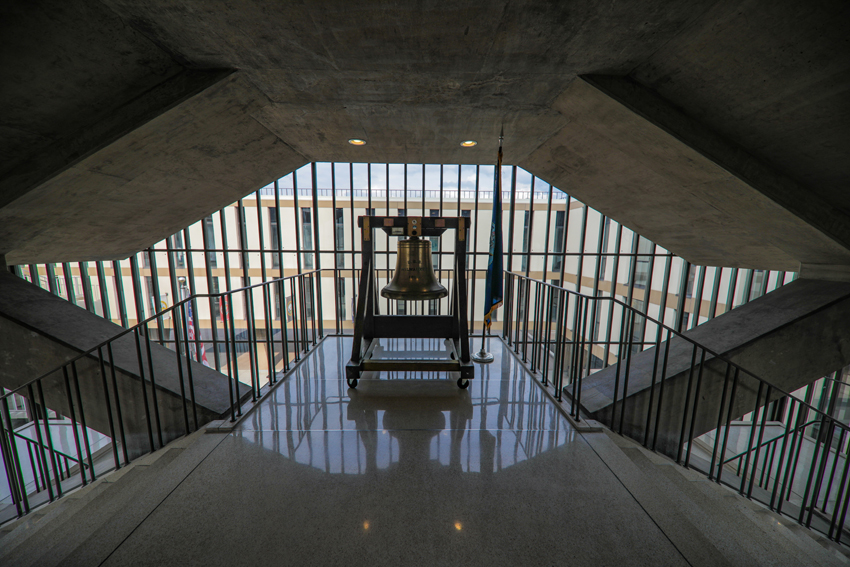
The incorporation of the VIG profile into the original, restored curtain system wall of the Bird Cage showed creative innovation at a lower cost than it would have been to tear it down and replace it with aluminum.
VIG Fundamentals
VIG is a glass solution with a growing footprint in the construction market. It is composed of two pieces of glass—or lites—in the thickness of a single pane, typically 0.12–0.23 inch. The gas in the space between the lites is extracted using either a small pump-out tube (also known as an evacuation port) or a vacuum chamber to create a vacuum rather than being filled with air or argon. The glass lites remain separated by pillars (or microspacers) that are approximately 0.005–0.012 inch thick and made of a high-strength material, such as metal or ceramic. They can be arranged in various patterns across the surface of the glass. The pillars may be either glued in place or held in place by the glass.
Once a vacuum is made, the edges are sealed to create a permanent vacuum. For units that have a visible pump-out tube, there may be a safety cap placed over the tube for additional durability. The pressure of the evacuated cavity is typically on the order of 0.1 Pa to eliminate the conductive and convective heat exchange between the two lites of glass. To reduce radiative heat exchange, a low-e coating can be used on one of the internal surfaces of the VIG, typically surface 2. Matching flatness on both lites of glass is critical to successful VIG fabrication to keep the array of pillars in place. Keeping the pillars in place prevents the lites from touching to avoid creating a thermal conduction pathway that could reduce the performance of the VIG.
VIG offers thermal performance values that surpass those of traditional IGUs and in some cases begin to rival solid walls. VIG also offers acoustic performance benefits and condensation resistance.
Current VIG Market Application
New Construction
VIG has a couple of key advantages over traditional glazing. Because VIG offers higher energy performance in a thinner profile, it allows for window and sash designs that are also much thinner and lighter than typical construction methods. A thinner profile product offers benefits in terms of wall thickness, window thickness, matching existing window extrusion design, and reducing the overall glazing component weight.
VIG also offers higher performance for a given profile. By utilizing the VIG either as a standalone product or in a hybrid VIG, manufacturers can exceed the performance values of typical IGU design required by model building codes. VIG can enable compliance with more stringent energy standards, such as Passive House Local Law 97.
Restoration
The thin profile of VIG allows buildings designed for the weight of monolithic glass to achieve and/or exceed the thermal performance of double-glazed or triple-glazed units. VIG can be used in an existing sash to reduce installation costs and maintain historic integrity. VIG also may be used as an interior storm lite for additional performance.
Refrigeration
Refrigeration applications typically require both low condensation potential and high insulation values. VIG offers significant benefits for the refrigeration market compared to traditional IGU construction, such as a slim profile, energy efficiency, and high visibility for consumers to see and access products. Safety requirements in commercial refrigeration can be met with tempering, lamination, or film— similar to architectural safety glass.
Energy Performance
Pillar array: The pillar array affects convection and conduction components of heat transfer. The distance between pillars can be increased if thicker glass or heat-treated glass is used. A wider pillar array allows for less heat transfer, so a lower (better) U-factor can be achieved. However, a wider array must not allow the two lites to touch, which may cause unacceptable glass distortion and be aesthetically unappealing.
Glass coating: The emissivity of the glass coating, along with the placement and number of coatings used, also drives energy performance. A higher-performing, low-emissivity coating can reduce both the solar heat gain coefficient and the U-factor, as in a standard IGU.
Vacuum level: Lower pressure reduces heat flow.
Conclusion
Glass is a multifunctional product. Glass need not be specified to satisfy just one design goal. For example, insulating glass can be used to meet energy requirements and maintain occupant comfort while indoors. It can be tempered or laminated to achieve a variety of safety and security performance levels. It can be decorated for aesthetic appeal or privacy, or to achieve bird-deterrence measures. And, by its nature, glass allows for natural daylight and views, which is a proven element in occupant physiological well-being. By now, you should be able to explain how new bird-friendly technologies are helping to reduce avian deaths across the country. You should be able to describe trends in using glass in home workspaces and office spaces, and how these daylighting options can lead to better health and well-being for occupants. And finally, you should be able to discuss the ways that glass currently is used for artistic and decorative expression, and provide examples of how VIG technology supports better building options when it comes to architectural glass construction.
Erika Fredrickson is an independent writer and editor focusing on technology, the environment, and history. She is a frequent contributor for continuing education courses and publications through Confluence Communications. www.confluencec.com
The National Glass Association (NGA) is the largest trade association serving the architectural glass and metals industry. A technical and educational resource, NGA envisions a future in which glass is the material of choice to enhance spaces where people live, play, learn, and work.
Originally published in Architectural Record
Originally published in July 2021
LEARNING OBJECTIVES
- Explain how new glass technologies can help support wildlife and bird safety through new anti-collision design.
- Describe new trends using glass for artistic and decorative expression in workspaces and commercial buildings that promote well-being and comfort.
- List some ways that daylighting has contributed to the health and well-being of students and workers.
- Discuss vacuum-insulating glazing and how it is used in various applications for the benefit of occupant safety, comfort, and well-being.











